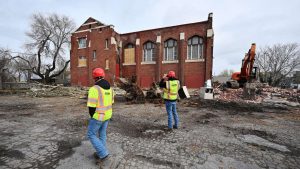Artists Lose Suit to Protect Work in Manhattan Jail Demolition
Published by John on
Two artists on May 18 lost a suit to protect their work from being destroyed along with a jail in New York City’s Chinatown neighborhood. Citing the federal Visual Artists Rights Act of 1990, Kit-Yin Snyder and Richard Haas had filed a suit in the U.S. District Court for the Southern District of New York asking that demolition of the Manhattan Detention Complex, which houses works commissioned by the artists through the city’s Percent for Art program, be halted. The pair were were supported in their effort by local activists Neighbors United Below Canal. Judge Lewis A. Kaplan, however, ruled that Snyder and Haas had failed to prove that the preservation of their work—a group of sculptures and a paving-stone design by the former and a set of seven murals and a pair of friezes by the latter—outweighed the public interest in demolishing the structure to make way for the world’s tallest jail.
City officials have said that they plan to temporarily move some of Snyder’s works—her Seven Columns of the Temple of Wisdom and a chair titled Throne of Solomon—to Riker’s Island. Her paving-stone work will be destroyed, as will all seven of Haas’s murals. His friezes The Judgements of Solomon and Pao Kung, which occupy the pedestrian bridge between the complex’s two buildings, will be stored at Riker’s Island. The works were all installed in 1992 and were created as part of a reconciliation plan agreed to by the city and Chinatown residents in the 1980s in relation to the approval of the complex’s construction.
The proposed thirty-plus-story jail at 124-125 White Street, has met with stiff resistance from a beleaguered Chinatown, which was battered by the pandemic as hate crimes against Asian Americans surged and tourists stayed away in droves, forcing numerous small businesses to close. Residents argue that the supertall jail will disrupt commercial activity in the area and that it endangers the livelihoods of Chinatown’s mostly immigrant elderly residents and small-business owners. New York City mayor Eric Adams, who during his campaign vowed to oppose the structure, has since embraced it.




